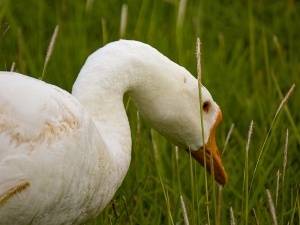
Ducks can look very different from each other, these birds can have differences in feather color, differences in size, and some birds may have growths were other birds don’t.
If you have a duck with a lump on its head you may be curious or even worried. This article explores why this happens.
Table of Contents
Duck with a lump on its head:
A change in your bird’s appearance can be confusing, a change is an outward sign that something on the inside of the bird is not the same. There are a variety of reasons why ducks may have bumps on their head, here are some of these reasons:
Crested ducks:
Some ducks will be born with a lump on their head, this is true for crested ducks. This type of duck has a deformity that keeps the skull of the bird from closing at the top, this results in a gap at the top of the bird’s skull.
A fatty tissue mass grows out of the skull opening causing a lump on top of the bird’s head. The fatty tissue mass is then covered by feathers but if the feathers are removed you can clearly see the fatty tissue mass at the top of this bird’s head.
What to do:
You don’t have to do anything if this is the type of bird you have, this is normal for this bird.
If you do own these types of ducks you’d need to keep in mind that the birds are prone to seizures, other neurological issues, and even early death.
It isn’t advisable that you breed two of these ducks as their eggs may not even hatch, if the eggs do hatch then the ducklings may die quite quickly after hatching.
Basal knob:
If the lump on your bird’s head is at the top of the bird’s beak then this may be a basal knob. The basal knob is said to be an indicator of health and sexual maturity in birds. The knob will change color and even become larger during the mating season.
The knob may go back to its normal size after the mating season.
What to do:
If you notice that the lump on your bird’s head changes around mating season then what you may be looking at is the bird’s basal knob.
Keep an eye on the bird during this time to see if this lump increases or decreases in size during this time.
A sting:
Insects don’t only sting humans, these tiny creatures are also known to sting other animals as well, ducks included. If an insect is able to get through a duck’s feathers to the bird’s skin then the duck may sting the bird at the top of its head.
The duck will avoid showing signs of being in pain if stung by an insect but you’ll know that the bird was stung if it suddenly develops a lump on its head.
What to do:
The sting on the bird’s head is likely quite painful and red, you can help relieve the pain on the bird’s head by using a cool compress on the sting, using some cooled oatmeal gruel on the lump may also help. The oatmeal helps soothe the skin
Infection:
Infections can develop almost anywhere on a duck’s body, and your bird may have developed one on top of its head.
If the bird was scratched or injured on the top of its head and bacteria was allowed to enter the opening then the bird may have developed an infection.
What to do:
An infection on top of the bird’s head can be serious, this infection can spread and cause havoc on the whole of the bird’s body if not addressed
Taking the bird to the vet is the recommended solution, the vet will be able to take blood samples from the bird to determine if the bird’s white blood count is high thus determining if the bird does indeed have an infection.
If the bird does have an infection then antibiotics will be given to treat the infection, this treatment will also help heal the lump on the bird’s head making it go down.
Tumor:
Tumors aren’t only a human condition, a variety of other animals can also develop tumors, ducks included. You don’t know if the bird has a tumor until the lump on the bird’s head is examined by a vet
Tumors on a ducks head can be caused by an over irritation of the area over a long period of time.
What to do:
If the above reason for the bird having a lump on its head is not the reason for the lump then the bird may have developed a tumor on its head.
The recommended course of action, in this case, is to take the bird to the vet to have the lump on its head biopsied to see if it is indeed a tumor.
You should not try to lance the tumor yourself as this can lead to a lot of bleeding as the tumors are usually packed full of blood cells and cutting it may also cause it to grow more rapidly.
If you enjoyed this article then you may also be interested in other duck related articles. Here are some articles that you may be interested in: Duck Swollen Crop, Duck Chest Swollen, Why Is My Duck Attacking Me?, Introducing Geese To Chickens

